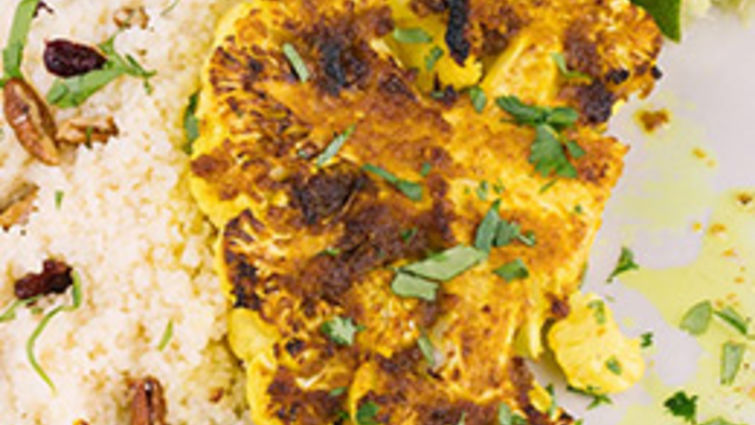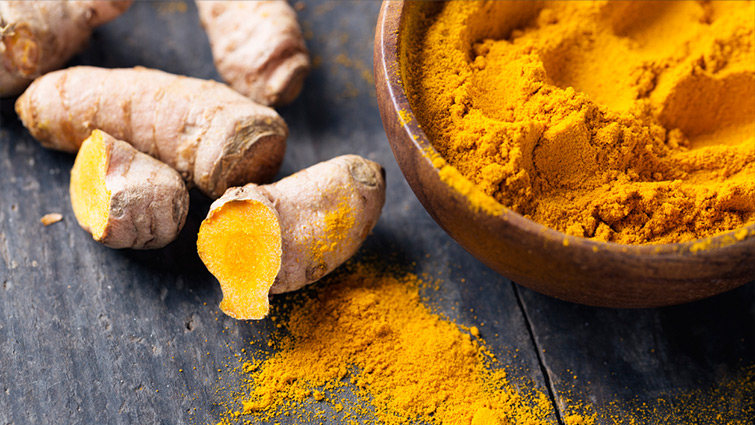Available in English, Spanish, French, Chinese, and Portuguese.
#liveitlomalinda
Broiled to perfection, these cauliflower “steaks” are seasoned with some of the most disease-fighting spices around: turmeric, ginger, cumin, garlic and cayenne.

Recipe: Cauliflower "Steaks"
Serving size: 4-5 Steaks
Servings per recipe: 4-5
Prep time: 40 min
Cook time: 12 min
- 1 Cauliflower head
- 1-2 Tbsp. vegetable oil
- 1/2 Tsp. kosher salt
- 1 Tsp. fresh grated turmeric (½ tsp. if powder)
- 1 Tsp. fresh grated ginger
- 1/2 Tsp. coriander, ground
- 1/2 Tsp. cumin, ground
- 1 Clove garlic, minced
- 1 Pinch cayenne chili powder
- 1 Tsp. brown sugar (or other dry sweetener)
- 1 Tbsp. parsley leaves, flat with stems removed
- 1 Tbsp. mint leaves, chopped with stems removed
- Juice of half a lime
Directions
Preheat oven to broil. Remove the leaves from the head of cauliflower and slice it into ¾ inch thick "steaks." Select the four best "steaks" from the center of the head and reserve the ends and loose pieces for another use. Brush each one with oil on both sides and arrange on an oiled baking sheet or nonstick mat.
Combine all the spices except the parsley and mint in a spice grinder (coffee grinder) or mortar and pestle and process until well combined and pulverized into a rub. Rub the spice mixture into the "steaks" until coated all over. Leave them to rest for 30 minutes.
Broil on high for seven minutes. Flip the "steaks" and continue cooking another four to five minutes until browned and tender. Monitor the cooking to prevent burning and adjust the pan as necessary. Garnish with the fresh herbs and season with a squeeze of lime juice.
*Serving suggestion: Serve whole on top of a flavorful grain such as rice, bulger, couscous, quinoa, etc. Can also be sauced with a thin yogurt drizzle or a chutney for added moisture and eye appeal.
*Cooking method can be altered to grill, pan sear, or roast with equally great results!
Nutrition Facts
Serving size:
| Calories | 60 |
| Total Fat | 4g |
| Saturated Fat | 0g |
| Trans Fat | 0g |
| Cholesterol | 0mg |
| Sodium | 210mg |
| Total Carbohydrate | 5g |
| Dietary Fiber | 1g |
| Total Sugars | 2g |
| Includes 1g Added Sugars | |
| Protein | 1g |
| Vitamin D | 0mcg |
| Calcium | 17mg |
| Iron | 1mg |
| Potassium | 180mg |

Star Ingredient:
Turmeric Contain:
Manganese*
What is manganese? A trace mineral essential for the body to metabolize fats and carbohydrates. In the body, it is found mostly in the bones and glands and is a cofactor for many enzymes, helping to facilitate dozens of metabolic processes. Manganese requirements are low, and plant foods such as nuts, whole grains, and green leafy vegetables contain significant amounts of this trace mineral. Deficiencies are therefore unlikely.
Iron*
Iron is a trace mineral most commonly known for maintaining hemoglobin levels. One of the most essential functions of iron is its production of red blood cells which provide oxygen to our tissues. Considering blood oxygenates the brain and iron is carried through the body by blood, iron is directly related to healthy brain function. A well-oxygenated body can lead to a feeling of well-being. Interestingly, vitamin C and iron consumed at the same time may increase the absorption of iron.
Trivia: Only carbohydrate, protein and fat supply energy to the body.
Vitamin B6*
All B vitamins play many specific roles in helping the enzymes to perform thousands of different molecular conversions in the body.
Vitamin B6 has been known to play roles in protein and amino acid metabolism. Besides a weakening immune response, vitamin B6 deficiency is expressed in general symptoms, such as weakness, irritability and insomnia. Other symptoms include a greasy, flaky dermatitis, anemia, and in advanced cases, convulsions. The richest food sources of vitamin B6 are protein-rich meat, fish and poultry. Potatoes, a few other vegetables, and some fruits are good sources, too. Foods lose vitamin B6 when heated.









